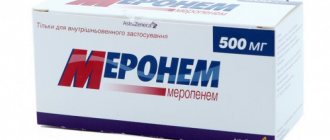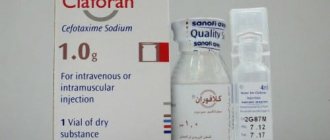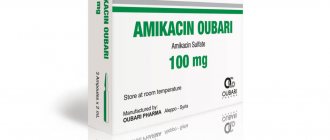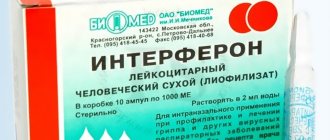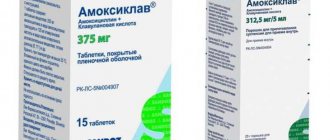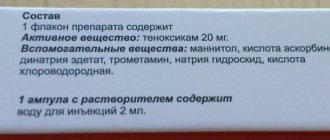Amoxiclav 1000 mg + 200 mg is an antibiotic, semi-synthetic penicillin with a beta-lactamase inhibitor.
White powder for the preparation of a solution for intravenous administration in a transparent, colorless glass bottle, closed with a rubber stopper, crimped with an aluminum cap with a plastic lid. The cardboard package contains 5 bottles of powder, as well as instructions for use of Amoxiclav 1000 mg + 200 mg for injection.
pharmachologic effect
The semi-synthetic antibiotic Amoxiclav 1000 mg + 200 mg has a wide spectrum of action. The composition of the drug includes 2 active substances. The main active substance, amoxicillin, is not resistant to destruction by beta-lactamases, but in combination with the bacterial enzyme inhibitor clavulanic acid, it retains maximum effectiveness against bacteria resistant to penicillins and cephalosporins.
The drug Amoxiclav 1000 mg + 200 mg is active against:
- Streptococci
- Staphylococcus
- Shigella
- Klebsiella
- Brucella
- Echinococcus
- Helicobacter
- Clostridia
- Haemophilus influenzae
- Salmonella
- Proteus
The drug Amoxiclav 1000 mg + 200 mg is ineffective against bacteria:
- Enterobacter
- Pseudomonas
- Chlamydia
- Mycoplasma
- Legionella
- Yersinia
Pharmacokinetics
When the drug is administered intravenously, therapeutic concentrations of active substances are found in the gall bladder, abdominal tissues, skin, adipose, muscle tissues, synovial, peritoneal fluids, bile, and purulent discharge.
The active substances of Amoxiclav 1000 mg + 200 mg weakly bind to blood plasma proteins.
Amoxicillin passes into breast milk, and trace amounts of clavulanic acid may also be found.
No negative effect on the fetus was detected when the active substances of the drug penetrate the placental barrier.
There may be a negative impact of Amoxiclav 1000 mg + 200 mg injections received by a nursing mother on the health of infants - diarrhea or candidiasis of the oral mucosa.
Amoxicillin is excreted by the kidneys, clavulanic acid is eliminated by extrarenal mechanisms. After Amoxiclav 1g has been administered intravenously, approximately 60-70% of the active substances are excreted by the kidneys after 6 hours.
note
If the patient suffers from renal failure, but the infection still needs to be fought, then Amoxiclav is prescribed taking into account creatinine clearance. The latter is a substance that must be completely excreted in the urine. Its concentration in urine and blood indicates the presence or absence of kidney pathology.
Knowing the creatinine content in the above biological fluids, as well as the patient’s age and body weight, calculations can be made using a special formula. This is how doctors evaluate the filtration capacity of the kidneys.
The critical value is considered to be 60 ml/min. Manufacturers of Amoxiclav have recalculated dosages for both adults and children, taking into account different clearance indicators. As a rule, such “complex” patients are not prescribed the drug in doses of 875 mg + 125 mg. Patients with low clearance levels are often prescribed Amoxiclav 250 mg + 125 mg 1-2 times a day or 500 mg + 125 mg 1 time a day. For children, the drug is prescribed in even lower dosages.
If the patient is on hemodialysis, then it is worth considering that 85% of the drug is eliminated during it. Therefore, you should give a new dose of Amoxiclav every time after it.
Pregnancy is not an absolute contraindication to the drug. However, we should not forget that it is able to penetrate the placental barrier, which means there is always a risk to the fetus. At the same time, the manufacturer reports that during the study of Amoxiclav, no cases of negative consequences regarding the health of the unborn child were identified.
Indications
Amoxiclav 1000 mg + 200 mg injection is used for diseases caused by simple or mixed infections. The effectiveness of the drug is superior to other drugs of the penicillin group. The drug helps against infections:
- upper respiratory tract, ENT organs of acute and chronic form (sinusitis, otitis media, tonsillitis);
- lower respiratory tract (exacerbation of chronic bronchitis, lobar pneumonia, bronchopneumonia);
- urinary tract (cystitis, urethritis, pyelonephritis);
- organs of the female reproductive system;
- skin, soft tissues, including animal bites;
- bones, joints;
- abdominal cavity, biliary tract (cholecystitis, cholangitis);
- sexually transmitted infections (gonorrhea, chancroid);
- prevention of infections after surgery.
About indications for use
They treat:
- respiratory tract (pulmonological and ENT profile);
- genitourinary infectious diseases in both men and women (cystitis, urethritis, pyelonephritis, prostatitis, ureaplasmosis, chlamydia);
- bacteria-affected skin, connective, bone and muscle tissue;
- biliary tract;
- oral cavity (dental profile).
Amoxiclav injections are given in the treatment of bacterial infections of the abdominal cavity, STIs, as a preventive measure after surgery.
The drug is prescribed for the treatment of acute and chronic diseases.
In pediatrics, it is usually used to treat bacterial infections of the respiratory system. Indeed, according to statistics, on average, children under five years of age suffer from three to six episodes of acute respiratory infections and acute respiratory viral infections per year, which do not go away without leaving a trace, but cause complications in the form of bronchitis, fever and other troubles. Therefore, most parents of preschool children are already familiar with Amoxiclav.
Contraindications
Negative reactions to the drug Amoxiclav 1000 mg + 200 mg occur if contraindications are not taken into account. Injections should not be used in the following cases:
- Intolerance to penicillins and clavulanic acid.
- Tendency to allergic dermatitis.
- Bronchial asthma.
- Severe forms of kidney and liver diseases.
- Mononucleosis.
- Lymphocytic leukemia.
Amoxiclav 1000 mg + 200 mg injections are prescribed with caution for pseudomembranous colitis, diseases of the gastrointestinal tract, liver failure, and severe renal dysfunction.
Dosage
Doses of Amoxiclav 1000 mg + 200 mg injection are set individually, taking into account age, body weight, and severity of the disease. The course should not exceed 14 days. Amoxiclav 1.2 g is not intended for intramuscular administration.
| Adults and children over 12 years of age or weighing more than 40 kg | Amoxiclav 1000 mg + 200 mg intravenously every 8 hours. In case of severe infection - at intervals of 6 hours. |
| Prophylactic doses for surgical interventions | Amoxiclav 1000 mg + 200 mg intravenously once during induction of anesthesia (for surgery lasting less than 1 hour). If the operation lasts more than 1 hour - up to 4 times a day. |
The cost of Amoxiclav in Russian pharmacies
The price of the drug depends on the form of release, dosage, number of doses and the trade markup of the wholesale and retail level of the pharmaceutical market.
Amoxiclav is included in the list of vital and essential drugs, which means its price is regulated by the state.
Cost of the most popular items:
- Amoxiclav tablet. p/p/o 500 mg + 125 mg No. 15 – 370-450 rub.;
- Amoxiclav tablet. p/p/o 875 mg + 125 mg No. 14 – 410-450 rub.;
- Amoxiclav por. d/prig. suspensions 125 mg + 31.25 mg / 5 ml – 110-120 rubles;
- Amoxiclav por. d/prig. suspensions 250 mg + 62.5 mg / 5 ml – 270-300 rubles;
- Amoxiclav por. d/prig. injection solution 1.2 g No. 5 – 830-890 rub.
When ordering online, the medicine is usually cheaper than directly from the pharmacy.
Preparation of solutions for intravenous injections
Dissolve the contents of the bottle with Amoxiclav powder 1000 mg + 200 mg with 20 ml of water for injection (no more). The drug should be administered intravenously using a syringe slowly (3-4 minutes). The drug must be administered within 20 minutes. after preparing the solution.
To administer the drug through a dropper, Amoxiclav 1200 mg is diluted in 100 ml of infusion solution. Infusion duration is 30-40 minutes.
When using the following liquids, the required concentrations of the antibiotic are maintained:
| Period of stability | ||
| at 25°C | at 5°C | |
| Water for injections | 4h | 8h |
| Sodium chloride solution 0.9% for intravenous infusion | 4h | 8h |
| Lactated Ringer's solution for intravenous infusion | 3h | |
| Calcium chloride and sodium chloride solution for intravenous infusion | 3h | |
Amoxiclav 1000 mg + 200 mg cannot be mixed with solutions of dextrose, dextran or sodium bicarbonate. Only clear solutions should be used. Prepared solutions should not be frozen.
Possible side effects
- Infectious, parasitic diseases (candidiasis of the skin, mucous membranes).
- Reversible leukopenia, thrombocytopenia (rare).
- Dizziness, headache, insomnia, agitation, anxiety, behavior changes (very rare).
- Convulsions (with impaired renal function).
- Diarrhea, nausea, vomiting, indigestion.
- Skin rash, itching, urticaria.
- Hepatitis, cholestatic jaundice (in men, as well as elderly patients with long-term therapy).
The listed symptoms can be observed during or immediately after completion of therapy with Amoxiclav 1000 mg + 200 mg; they rarely appear several weeks after completion. Side effects from the injections are reversible, but those affecting the liver can be severe.
About the side effects of antibiotics
Any drug, regardless of manufacturer, composition, or high cost, can lead to undesirable consequences. Amoxiclav is no exception.
Taking the drug may cause nausea, loss of appetite, vomiting, diarrhea and/or abdominal pain. Among the adverse reactions, the manufacturer lists allergic rash, itching, urticaria, headaches, and dizziness. The package insert for the drug states that rare cases of liver dysfunction, anaphylactic shock, reversible leukopenia, seizures, etc. have been recorded.
Adult patients and parents of young patients should not be afraid of the large list of side effects of Amoxiclav. This only means that the drug has been carefully studied by the manufacturer.
It is worth paying attention to the fact that the drug can cause poisoning or increase side effects if you neglect the dosages recommended by the manufacturer. When should you call emergency services or see a doctor yourself? Symptoms of an overdose of Amoxiclav:
Symptoms of an overdose of Amoxiclav:
- dysfunctions of the gastrointestinal tract, leading to a significant deterioration in overall health;
- anxiety, insomnia, dizziness and even convulsions.
The problem can be solved by adjusting the dosage and/or treating the above symptoms. If you have recently taken the drug, gastric lavage and activated charcoal are recommended. You can also remove Amoxiclav from the body by hemodialysis using an artificial kidney machine.
Overdose
There are no reports of death or life-threatening side effects due to an overdose of Amoxiclav 1000 mg + 200 mg injections.
Symptoms from the gastrointestinal tract may be observed (stomach pain, diarrhea, vomiting), disturbances in water and electrolyte balance, and anxiety, insomnia, dizziness, and rarely convulsive seizures are also possible.
Amoxicillin crystalluria is possible, sometimes leading to the development of renal failure.
After intravenous administration of large doses of amoxicillin, it can settle in urinary catheters, so regular checking of the patency of urinary catheters is necessary.
In case of an overdose of Amoxiclav 1000 mg + 200 mg, the patient should be under medical supervision. If there are symptoms from the gastrointestinal tract, symptomatic therapy is carried out. The active substances of the drug can be removed from the bloodstream by hemodialysis.
Buy Amoxiclav powder for the preparation of suspension orally 125 mg + 31.25 mg/5 ml 100 ml in pharmacies
Amoxiclav Buy Amoxiclav in pharmacies DOSAGE FORMS powder for the preparation of a suspension for oral administration 125mg+31 25mg/5ml powder for the preparation of an oral suspension 125mg+31 25mg/5ml 20dz
MANUFACTURERS Lek dd. (Slovenia)
GROUP Combined antimicrobial agents
COMPOSITION Active substance: amoxicillin + clavulanic acid.
INTERNATIONAL NON-PROPENTED NAME Amoxicillin + Clavulanic acid
SYNONYMS Amoxiclav Quiktab, Arlet, Augmentin, Augmentin EU, Augmentin SR, Clamosar, Medoclav, Panclave, Ranclave, Rapiclav, Sinulox, Sinulox RTU, Flemoclav Solutab, Ecoclave
PHARMACOLOGICAL ACTION Broad spectrum antibacterial. Blocks the synthesis of peptidoglycan of the membrane of microbial cells (amoxicillin), inhibits beta-lactamases (clavulanic acid). Clavulanic acid forms a stable inactivated complex with these enzymes and protects amoxicillin from the loss of antibacterial activity caused by the production of beta-lactamases by the main pathogens and opportunistic microorganisms. Active against gram-positive aerobes: Streptococcus pneumoniae, S.pyogenes, S.viridans, S.bovis, Staphylococcus aureus (except methicillin-resistant strains), S.epidermidis (except methicillin-resistant strains), Listeria spp., Enterococcus spp. Gram-negative aerobes: Bordetella pertussis, Brucella spp., Campylobacter jejuni, E.coli, Gardnerella vaginalis, H.influenzae, H.ducreyi, Klebsiella spp., Moraxella catarrhalis, N.gonorrhoeae, N.meningitidis, Pasteurella multocida, Proteus spp., Salmonella spp., Shigella spp., Vibrio cholerae, Yersinia enterocolitica. Anaerobes: Peptococcus spp., Peptostreptococcus spp., Clostridium spp., Bacteroides spp., Actinomyces israelii. Rapidly absorbed after oral administration (food intake does not affect absorption). The maximum concentration is reached 1 hour after administration. The maximum plasma concentration after a bolus injection of 1.2 g is 105.4 mg/l (for amoxicillin) and 28.5 mg/l (for clavulanic acid). It has a large volume of distribution - high concentrations are found in body fluids and tissues (lungs, pleural, peritoneal, synovial fluid, tonsils, bronchial secretions, prostate gland, peritoneal abscess, muscle tissue, adipose tissue, paranasal sinus secretions, middle ear, etc. .). Peak concentrations in body fluids are observed 1 hour after peak plasma concentrations are reached. Does not pass through the BBB when the meninges are not inflamed, passes through the placental barrier and penetrates into breast milk in trace concentrations. Weakly binds to plasma proteins. Amoxicillin is partially metabolized, clavulanic acid undergoes intensive metabolism. Amoxicillin is excreted by the kidneys almost unchanged by tubular secretion and glomerular filtration; clavulanic acid - by glomerular filtration, partly in the form of metabolites. Small amounts are excreted by the intestines and lungs. The half-life is 1-1.5 hours, with severe renal failure it increases to 7.5 (for amoxicillin) and 4.5 hours (for clavulanic acid). It is removed during hemodialysis, and slightly - during peritoneal dialysis.
INDICATIONS FOR USE Infectious diseases of the upper (acute and chronic sinusitis, acute and chronic otitis media, retropharyngeal abscess, tonsilopharyngitis) and lower respiratory tract (acute and chronic bronchitis, pneumonia, pleural empyema); urinary tract infections (including cystitis, urethritis, pyelonephritis), gynecological infections (including salpingitis, salpingoophoritis, endometritis, septic abortion, pelvioperitonitis); biliary tract (cholecystitis, cholangitis), bone and connective tissue (including chronic osteomyelitis), skin and soft tissue (phlegmon, wound infection), odontogenic infections (periodontitis); sexually transmitted infections (gonorrhea, chancroid).
CONTRAINDICATIONS Hypersensitivity; history of allergic reactions to antibiotics of the penicillin and cephalosporin group; cholestatic jaundice, hepatitis caused by taking penicillin antibiotics (in history); liver failure; infectious mononucleosis, lymphocytic leukemia. Use during pregnancy and breastfeeding: Possible if the expected effect of therapy exceeds the potential risk to the fetus. Breastfeeding should be stopped during treatment.
SIDE EFFECTS In most cases, side effects are weak and transient, most often affecting the gastrointestinal tract: loss of appetite, nausea, vomiting, diarrhea. Possible development of superinfection, stomatitis, vaginitis; in rare cases - pseudomembranous colitis with severe diarrhea. Allergic reactions may occur: itching, skin rashes; in sensitive patients, immediate hypersensitivity reactions may develop (angioedema, bronchospasm, rarely - anaphylactic shock). It is extremely rare that a transient increase in the level of transaminases in the blood plasma can be observed. There are isolated reports of cholestatic jaundice, hepatitis, and liver dysfunction.
INTERACTION When used simultaneously with methotrexate, the toxicity of methotrexate increases, with allopurinol - the incidence of exanthema, and with anticoagulants - the prothrombin time is prolonged. Reduces the effectiveness of oral contraceptives. Concomitant use with disulfiram should be avoided. The effectiveness of Amoxiclav is weakened by combination with bacteriostatic antibiotics (macrolides, tetracyclines); combination with rifampicin is antagonistic. Probenecid reduces the excretion of amoxicillin, increasing its serum concentration. Pharmaceutically incompatible with solutions containing blood, proteins, lipids, glucose, dextran, bicarbonate. Do not mix in a syringe or infusion bottle with other drugs. Incompatible with aminoglycosides.
OVERDOSE Symptoms: in most cases nausea, diarrhea, vomiting, possible agitation, insomnia, dizziness, and in some cases seizures. There are no reports of deaths or life-threatening side effects. Treatment: symptomatic, in case of recent use (less than 4 hours), remove the drug from the gastrointestinal tract (gastric lavage, taking activated charcoal to reduce absorption), hemodialysis is effective.
SPECIAL INSTRUCTIONS Prescribe with caution to patients prone to allergic reactions to cephalosporins and other beta-lactam antibiotics (risk of cross-sensitivity), with severe impairment of liver and kidney function (dosage regimen adjustment is necessary). High concentrations give a false positive reaction for glucose in urine when using Benedict's reagent or Felling's solution (it is recommended to use enzymatic reactions with glucose oxidase).
STORAGE CONDITIONS List B. At room temperature.
Drug interactions
Concomitant use of probenecid, which reduces the tubular secretion of amoxicillin, is not recommended. Simultaneous treatment with Amoxiclav 1000 mg + 200 mg may lead to an increase in the concentration of amoxicillin, but not clavulanic acid.
Diuretics, allopurinol, phenylbutazone, nonsteroidal anti-inflammatory drugs (NSAIDs), which block tubular secretion, increase the concentration of amoxicillin (clavulanic acid is eliminated by glomerular filtration).
Simultaneous use of Amoxiclav 1000 mg + 200 mg with methotrexate increases the toxicity of the latter.
Bacteriological drugs (macrolides, chloramphenicol, lincosamides, tetracyclines, sulfonamides) have an antagonistic effect. Amoxiclav 1000 mg + 200 mg reduces the effectiveness of drugs whose metabolism produces para-aminobenzoic acid, ethinyl estradiol - the risk of breakthrough bleeding.
The antibiotic increases the effectiveness of indirect anticoagulants (by suppressing intestinal microflora, reducing the synthesis of vitamin K).
In some cases, Amoxiclav 1000 mg + 200 mg substances may prolong prothrombin time, which requires caution when using anticoagulants simultaneously.
The simultaneous use of allopurinol and Amoxiclav may increase the risk of allergic skin reactions.
When Amoxiclav is combined with rifampicin, a mutual weakening of the antibacterial effect is observed.
The simultaneous use of Amoxiclav injections with disulfiram should be avoided.
The drug is chemically incompatible with aminoglycoside antibiotics.
The simultaneous use of Amoxiclav and digoxin may increase its concentration.
The drug reduces the effectiveness of oral contraceptives.
Pharmaceutical incompatibility of injections of the drug Amoxiclav 1000 mg + 200 mg with blood products and other protein-containing liquids. When using aminoglycosides simultaneously, do not mix the medicine in the same syringe or vial for intravenous injection.
Avoid mixing Amoxiclav with injections of dextrose, dextran, sodium bicarbonate.
Combination with other drugs
If the patient takes ascorbic acid (vitamin C) in parallel with Amoxiclav, this will only improve the absorption of the antibiotic. But some other drugs can slow down this process, in particular:
- antacids (Almagel, Phosphalugel, Smecta, etc.);
- medications containing glucosamine (Teraflex, Artra);
- laxatives (Senadexin, Guttalax, Bisacodyl);
- aminoglycosides (Gentamicin, Amikacin).
The attending physician should also take into account that diuretics (Furosemide, Torasemide), Allopurinol, Phenylbutazone, non-steroidal anti-inflammatory drugs (Ibuprofen, Nimesulide) and some other drugs block tubular secretion of the kidneys. This means that their simultaneous use with Amoxiclav increases the concentration of amoxicillin, leading to increased side effects and overdose. By the way, clavulanic acid “does not suffer” from this interaction. It is derived mainly in a different way.
The interaction of other drugs with Amoxiclav has also been studied. You should be careful when prescribing and taking this drug with Methotrexate, Disulfiram, Rifampicin, macrolide and tetracycline antibiotics, and sulfonamides.
special instructions
Before starting treatment with Amoxiclav 1000 mg + 200 mg, the patient must be interviewed to identify hypersensitivity reactions to penicillins, cephalosporins or other beta-lactam antibiotics. Serious hypersensitivity reactions to penicillins have been described. If you have an allergic reaction to injections, you should stop treatment and prescribe appropriate alternative therapy.
For serious anaphylactic reactions, epinephrine should be administered immediately. Oxygen therapy, intravenous glucocorticosteroids, and airway management, including intubation, may also be required.
If infectious mononucleosis is suspected, Amoxiclav 1000 mg + 200 mg should not be used, since amoxicillin can cause a measles-like rash in patients, which makes diagnosing the disease difficult.
Amoxiclav 1000 mg + 200 mg injections are prescribed with caution to patients with signs of liver failure.
Cases of pseudomembranous colitis have been described, and the severity can range from mild to life-threatening. The use of drugs that inhibit intestinal motility is contraindicated.
In general, the drug is well tolerated and has the low toxicity characteristic of all penicillins. During a course of treatment with injections of Amoxiclav 1000 mg + 200 mg, it is necessary to monitor the function of the hematopoietic organs, liver, and kidneys.
Certificate of Analysis 1000mg + 200mg
Use during pregnancy and breastfeeding
There is no data on the harmful effects of Amoxiclav 1000 mg + 200 mg injections on the fetus, but the results of individual studies suggest a connection between the course of treatment and premature rupture of the membranes. There are isolated examples of the development of necrotizing enterocolitis, diarrhea, and candidiasis in infants. Amoxiclav is used during pregnancy and lactation if the benefit of the treatment course for the mother significantly outweighs the potential risk for the child.
The penetration of active substances into breast milk is insignificant; if there are clear indications, injections of Amoxiclav 1000 mg + 200 mg can be prescribed. If the baby develops diarrhea or candidiasis due to injections, the use of the drug should be discontinued.
Use in children
Doses are given based on the content of active substances. Every 30 mg of Amoxiclav 1000 mg + 200 mg contains 25 mg of amoxicillin, 5 mg of clavulanic acid.
For children weighing less than 40 kg, the injection dose is calculated based on weight.
- Up to 3 months with body weight less than 4 kg - 30 mg/kg every 12 hours.
- Up to 3 months with body weight more than 4 kg - 30 mg/kg every 8 hours.
The drug Amoxiclav 1000 mg + 200 mg is administered slowly by infusion (30‒40 minutes).
- For children from 3 months to 12 years: 30 mg/kg body weight at intervals of 8 hours, in case of severe infection - at intervals of 6 hours.
How to use
The exact dosage regimen is inserted by the doctor individually, depending on the severity of the disease and the healing effect. The duration of treatment with an antibiotic can be from 5 to 14 days.
Pills
Take orally just before eating, swallowing whole, without chewing and washing down with water.
As noted in the instructions, adults and children weighing more than 40 kilograms with pathologies of mild and moderate severity are prescribed 1 tablet (250 milligrams/125 milligrams) every 8 hours (3 times throughout the day) or 1 tablet (500/125 milligrams) ) every 12 hours (2 times throughout the day); in severe forms of the disease, 1 tablet of 500 milligrams/125 milligrams is prescribed every 8 hours (three times throughout the day) or 1 tablet of 875 milligrams/125 milligrams every 12 hours (twice throughout the day).
Amoxiclav Quiktab tablets
Before use, the tablet must be dissolved in 100-150 milliliters of water and stirred very well. Adults and children over 12 years of age are prescribed 1 tablet (500 milligrams/125 milligrams) 2-3 times a day; for severe conditions - 1 tablet (875 milligrams/125 milligrams) twice a day.
Powder for parenteral use
To prepare a solution for intravenous administration, dissolve the contents of the bottle in water for injection (for Amoxiclav 600 milligrams - 10 milliliters; for Amoxiclav 1.2 grams - 20 milliliters). Then the resulting solution is administered intravenously slowly over 4-5 minutes.
If the medicine must be administered as an intravenous infusion, then 600 milligrams of the medicine are diluted in 10 milliliters of water for injection and added to the infusion solution (50 milliliters). Antibiotic 1.2 grams is diluted in 20 milliliters of water for injection and added to 100 milliliters of infusion solution. The drug is administered dropwise over 30-40 minutes. Freezing of funds is not permitted.
Suspension
Shake the bottle with the powder very well, add warm boiled water (up to the mark) in 2 additions, shaking each time until the powder is completely dissolved.
In pediatrics, newborns and infants up to 3 months are prescribed a medicine at the rate of 30 milligrams per 1 kilogram of weight (daily dose), this amount must be divided and given in 2 doses at equal, irregular intervals.
From 3 months, the antibiotic is prescribed at a dose of 25 milligrams per 1 kilogram of body weight, which is also divided equally into 2 doses. For infectious diseases of moderate severity, 20 milligrams per 1 kilogram of body weight are prescribed and divided into 3 administrations. In severe conditions, the dose is greater - 45 milligrams per 1 kilogram of weight and divided into 2 injections throughout the day.
Use for renal impairment
Dosage adjustment of Amoxiclav 1000 mg + 200 mg is not required if creatinine clearance is more than 30 ml/min. In other cases, the antibiotic is contraindicated or requires serious dosage adjustment.
The total clearance of amoxicillin/clavulanic acid decreases in proportion to the decrease in renal function. The decrease in clearance is more pronounced for amoxicillin than for clavulanic acid, because Most amoxicillin is excreted by the kidneys. Doses of Amoxiclav 1000 mg + 200 mg for renal failure should be selected taking into account the undesirability of amoxicillin accumulation while maintaining normal levels of clavulanic acid.
Instructions for use
A treatment regimen with tablets and a solution for preparing a suspension for oral administration is prescribed to the patient by a doctor.
When determining the dosage of the drug and the duration of its use, it takes into account several factors: the severity of the infection, the patient’s age, his body weight, and the state of kidney function.
Amoxiclav in tablets and suspension form is taken orally during meals, which minimizes the risk of side effects from the digestive system.
The duration of the entire course of treatment is one to two weeks. Continuation of treatment after two weeks is possible only after a second medical examination.
There are two different regimens for taking Amoxiclav, which are determined by the severity of the infection.
If the infection is mild or moderate in nature, the following dosages are prescribed:
If the infection is severe, use a larger dosage and take the tablets more often:
Amoxiclav suspension can be given even to children under 3 months. This is done, of course, exclusively as prescribed by a doctor. The dose of the drug for infants is prescribed according to the calculation of amoxicillin. This dose is specifically determined by the doctor, but it should be no more than 30 mg/kg. in a day.
The drug is taken every 12 hours.
For children over three months of age, 20 to 30 mg/kg is indicated. the drug for mild and moderate forms of the disease and up to 40 mg/kg. medications per day (including amoxicillin) - for severe illness and advanced infection.
The primary indicator when choosing the dosage of the drug is not the age of the child, but his body weight and the severity of the infection.
Analogs
Analogues of Amoxiclav 1000 mg + 200 mg in powder for injection contain a combination of the substances amoxicillin and clavulanic acid. Preparations with one of the components do not have a wide spectrum of drug action.
Complete analogues:
- Augmentin;
- Clamosar;
Cheap analogues with the same active ingredient:
- Amoxicillin;
- Amosin;
Substitutes with a similar effect, but a different active ingredient:
- Azithromycin;
- Flemoxin Solutab;
- Sumamed;
- Suprax;
Composition and action
The main active ingredients are amoxicillin and clavulanic acid. The combination of these active substances provides a pronounced therapeutic effect of the antibiotic. Thanks to clavulanic acid, Amoxiclav can also be prescribed for infections that are resistant to amoxicillin.
The antibacterial drug has a pronounced bactericidal and bacteriostatic effect on almost all types of streptococci (with the exception of methicillin-resistant strains), listeria, and echinococci. Gram-negative bacteria are also sensitive to the drug: Klebsiella, Brucella, Moraxella, Salmonella, Gardnerella, Proteus, Clostridium and others.
The maximum concentration of the antibiotic is achieved within 1 hour after taking the drug. The active ingredients, regardless of the method of administration, are quickly distributed in the tissues and fluids of the body (middle ear, lungs, uterus, ovaries, peritoneal and pleural fluids, adipose and muscle tissues, sinuses, tonsils, and so on).
The drug is excreted from the body through the kidneys (half-life for healthy kidneys is 1-1.5 hours). A small amount of clavulanic acid metabolites is excreted in exhaled air and feces.
The medicine does not penetrate the lining of the brain and the cerebrospinal fluid; this feature significantly reduces the risk of unpleasant side reactions from the central nervous system.
Price
Dear readers, the price list for Amoxiclav 1000 mg + 200 mg injections is updated on our website once a day, which is why the prices indicated in it may differ from the real ones. Hope for your understanding.
| Drug name | Price for 1 unit, rub. | Price per package, rub. | Link |
| Amoxiclav® powder for the preparation of solution for intravenous administration 1000 mg + 200 mg, 5 pcs. | |||
| 170.4 | 852.00 | Buy | |
| 169.2 | 846.00 | Buy | |
| 175.2 | 876.00 | Buy | |
| 103.6 | 518.00 | Buy | |
| 164 | 820.00 | Buy | |
| 155 | 775.00 | Buy | |
| Amoxiclav® powder for the preparation of solution for intravenous administration 1000 mg + 200 mg, 5 pcs. | |||
| 169.2 | 846.00 | Buy | |
| 175.2 | 876.00 | Buy |
Sources
- https://www.sandoz.ru/news/media-releases/the-company-sandoz-represents-a-novelty-in-the-children-line-amoxiklav-quicktab
- https://studfiles.net/preview/5243279/page:4/
- https://fb.ru/article/408242/amoksiklav-proizvoditel-instruktsiya-po-primeneniyu-analogi
- https://www.rlsnet.ru/tn_index_id_219.htm#proizvoditel%60
- https://farmamir.ru/2015/07/amoksiklav-instrukciya-primenenie-otzyvy/
- https://sportwiki.to/Distribution_of_medicines
- https://infekc.ru/infekcionnue/odontogennye-infekcii-simptomy-i-lechenie.html
Alla Kanchar, Pharmacy, pharmacist 4 articles on the site
Graduated from Lugansk State Medical University. She defended her thesis on the topic: “Prospects for the development of an ophthalmic dosage form based on a phytochemical substance obtained from the herb Canadian petal.” I work as a pharmacist in a pharmacy in Lugansk.
